#Urodela
Text
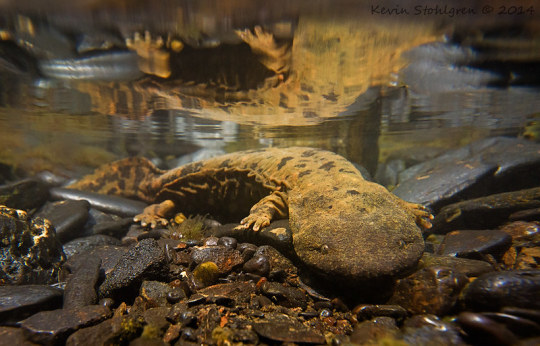
An Eastern hellbender (Cryptobranchus a. alleganiensis) also known as the snot otter, devil-dog, lasagna lizard, grampus, mud devil, or Allegheny alligator, in Tennessee, USA
by Kevin Stohlgren
#hellbender#giant salamanders#salamanders#amphibians#cryptobranchus alleganiensis#cryptobranchus#cryptobranchidae#urodela#amphibia#chordata#wildlife: tennessee#wildlife: usa#wildlife: north america
1K notes
·
View notes
Photo
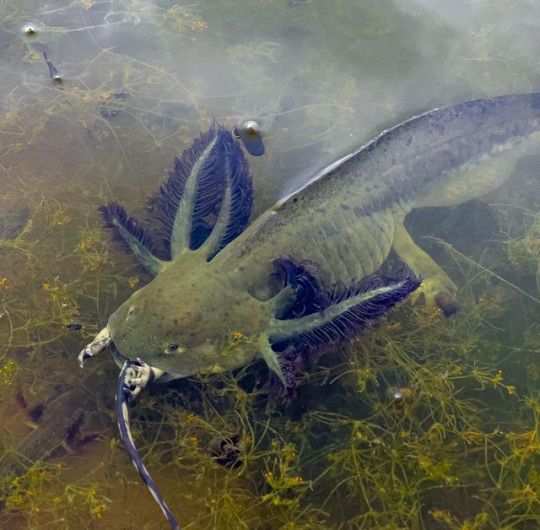
Barred Tiger Salamander
#western tiger salamander#barred tiger salamander#salamander#Ambystoma mavortium#mole salamander#Amphibia#Urodela#Ambystomatidae#Ambystoma#upl
2K notes
·
View notes
Text
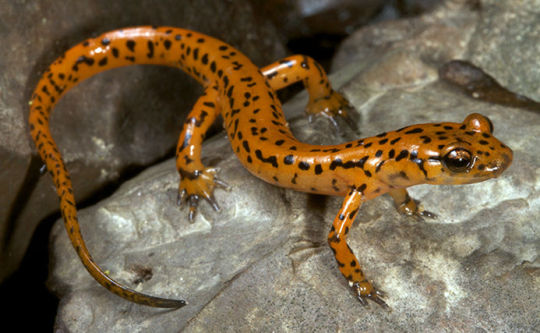


Shine a Light on the Cave Salamander
The cave salamander, also known as the spotted salamander (Eurycea lucifuga) is a species of salamander found throughout the eastern United States, particularly in the Appalachian mountains. As the name implies, they are most common in caves with exposed limestone or other calcifying rocks. However, they may also occur under rocks or logs, or in streams in deciduous forests; anywhere that's dark and moist.
The spotted salamander spends almost its entire life in these 'twilight zones'. Mating is believed to occur in summer or early fall, when male salamanders begin to seek out females by tracking their pheromones. Once a male finds a potential mate, he nudges her and rubs his chin on her head until she indicates she's receptive. At that point she straddles his tail while the two walk in tandem. The male then drops a spermatophore-- a sack full of sperm-- on the ground, and the female picks it up with her cloaca. The female lays a clutch of 5 to 120 eggs, but not until several months after fertilization between September and February.
The eggs take about 20 days to hatch, and larvae entirely aquatic, complete with gills and webbed fingers. Individuals can take anywhere from 6 to 18 months to fully develop, at which point they leave the water and become fully nocturnal. However, most individuals don't stray far from their original spawning territory, and adults do not maintain or defend set territories.
Despite their reclusive lifestyle, cave salamanders are quite striking. Adults are bright orange or red with black spots, and can be anywhere from 10 to 20 cm (4 to 8 in) in length. Over half of that length is taken up by the tail, and males have a longer tail than females. As lungless salamanders, E. lucifuga breathes through its skin and the tissues around its mouth-- while useful for an aquatic animal, this type of respiration makes it essential that the cave salamander remains in a wet environment.
Both larvae and adults are insectivorous, consuming a number of invertebrates including spiders, snails, beetles, earthworms, and ticks. Potential predators of the spotted salamander include bats, shrews, racoons, and snakes, though few specifics are known about the species' ecology. To deter these predators, E. lucifuga adopts a defensive posture in which they coil their body and wave their tail over their head. In addition, they secrete a foul-tasting substance from their skin, and their bright coloration likely warns potential predators that they won't make a good meal.
Conservation status: The IUCN has classified the cave salamander as Least Concern, although they are listed as Endangered in several of the American states in which they occur. The greatest threat to the species is thought to be human disturbance or habitat degredation from pollution of the water systems which flow through the caves where E. lucifuga resides.
If you like what I do, consider leaving a tip or buying me a kofi!
Photos
Todd Pierson
Michael Graziano
#cave salamander#Urodela#Plethodontidae#brook salamanders#lungless salamanders#salamanders#amphibians#caves#cave amphibians#north america#eastern north america#biology#zoology#ecology#animal facts
159 notes
·
View notes
Text
Taxonomy Tournament: Chordata
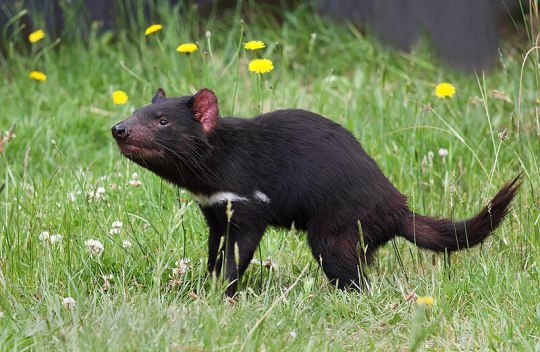

Dasyuromorphia. This order is made up of carnivorous marsupials, including quolls, numbats, and the Tasmanian devil.
Urodela. This order is made up of amphibians that have a tail, such as newts and salamanders, including the axolotl.
#animals#biology#polls#poll tournament#zoology#tasmanian devils#numbats#mammals#tetrapods#salamanders#axolotl#amphibians#Dasyuromorphia#Urodela#0x10v0x2f
83 notes
·
View notes
Text




Red-spotted Newt (Notophthalmus viridescens viridescens) - Southwest Ohio, 3/24/2023
#newt#salamander#urodela#salamandridae#Notophthalmus#Notophthalmus viridescens#Eastern Newt#Notophthalmus viridescens viridescens#red-spotted newt
78 notes
·
View notes
Text
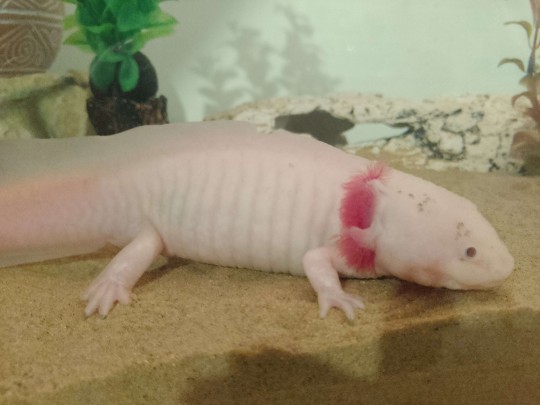
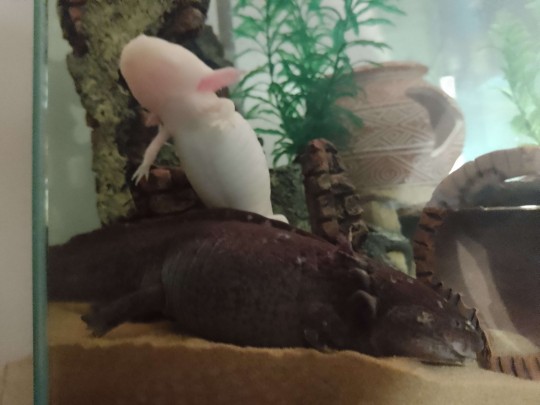
Please look at my babies ♡
Picture 1: Undyne, a leucistic axolotl, 8 yo. She's missing 2 gills due to a mycosis outbreak when she was very tiny. She's the most fierce of the tank ♡ namesake: Undyne from Undertale.
Picture 2: The wild axolotl is Diego, 8 yo, Undyne's sibling. Hefty baby ♡ I love his depigmented spots! We're keeping an eye on his weight. Axolotls eat even when they aren't hungry, so... :') namesake: Diego Brando from Steel Ball Run.
The leucistic axolotl is Misty, 4 yo. Either Undyne or Diego's child. They produced eggs back when we had a male axolotl named Gamzee, who unfortunately died. I kept Misty and watched her grow. Crazy to think that she used to fit in a tablespoon 🥺 namesake: Lizard Misty from Saint Seiya.
The three of them are females!
#gab talks#pets#animals#axolotl#axolotls#urodela#ambystoma#ambystoma mexicanum#salamander#salamanders#amphibians#amphibian
8 notes
·
View notes
Text

“You shine so bright, why must have your gleam fell from delight ?„
• Yoooo is that a Blumani child ?? Yes !! Meet Shiny, a Blumiere x Timpani child <3
───── ⋆⋅☆⋅⋆ ─────
* Credits.
Blumiere/Count Bleck and Timpani belongs to Super Paper Mario !!
───── ⋆⋅☆⋅⋆ ─────
* Info.
- phantom..
- is a bit sassy at times.. was born rich, lived spoiled.
- monocle is specially made to see ghosts, and people with invisible powers !!
__________________ ׂׂૢ་༘࿐
┊ ⋆ ┊ . ┊ ┊
┊ ┊⋆ ┊ .
┊ ┊ ⋆˚
✧. ┊
⋆ ★
#blumani#mdraw#ship child#fanchild#timpani#timpani spm#spm timpani#spm tippi#count bleck#count bleck spm#spm count bleck#count blumiere#blumiere#blumiere spm#timpani x blumiere#Blumiere x timpani#Shiny#Urodela#<333#ref
62 notes
·
View notes
Text
4 notes
·
View notes
Photo

26 notes
·
View notes
Photo



Axolotl
The axolotl genome is the second longest in the animal kingdom, with 32 billion base pairs. That’s 10 times as long as the human genome.
The impossibly silly branches that grow from the axolotl’s head might not seem practical, but they’re actually the salamander’s gills. The filaments attached to the long gills increase surface area for gas exchange.
It’s not unusual for amphibians to be able to regenerate, but axolotls take it to the next level. On top of being able to regenerate limbs, the animal can also rebuild their jaws, spines, and even brains without any scarring.
The rarest axolotl color that is practically obtainable in real life is the firefly color. It is dark, like the wild type axolotl, but with a fluorescent green tail that glows in the dark. Other very rare but almost impossible to obtain axolotl colors include enigma, chimera and mosaic.
They’re critically endangered. A 2019 assessment by the International Union for the Conservation of Species found only between 50 and a thousand axolotls are left in the wild - and their populations are dropping.
4 notes
·
View notes
Text
Not a frog (Anuran), not a salamander (Urodele), but a secret third thing.
1 note
·
View note
Text

A group of olms (Proteus anguinus) in Grotte de Choranche, France
by Thierry Balint
#olm#salamanders#amphibians#proteus anguinus#proteus#proteidae#urodela#amphibia#chordata#wildlife: france#wildlife: europe
3K notes
·
View notes
Text

Yellow-eyed Ensatina
#yellow eyed ensatina#salamander#Ensatina eschscholtzii xanthoptica#Ensatina eschscholtzii#Amphibia#Urodela#Plethodontidae#Plethodontinae#Ensatina#upl
39 notes
·
View notes
Text
Uncharismatic Fact of the Day
In the animal kingdom, sentimentality doesn't go very far. Female red back salamanders spend about two months guarding their clutch, which contains anywhere from 4 to 17 eggs. However, if any of the eggs die she won't hesitate to eat them-- not only does she gain valuable nutrients, but eating the dead eggs helps prevent the spread of infection to the rest of the clutch. Though it may seem gruesome, this behavior is common among egg-laying animals.

(Image: A red back salamander (Plethodon cinereus) by Will Lattea)
If you send me proof that you’ve made a donation to UNRWA or another organization benefiting Palestinians– including esim donations– I’ll make art of any animal of your choosing.
#red back salamander#Urodela#Plethodontidae#woodland salamanders#lungless salamanders#salamanders#amphibians#uncharismatic facts
80 notes
·
View notes
Text
Taxonomy Tournament: Amphibians* Finale
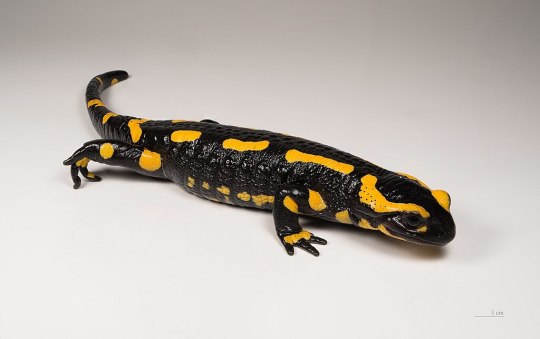

Urodela. This order is made up of amphibians that have a tail, such as newts and salamanders, including the axolotl.
Non-Tetrapod Lobe-finned Fish. This class is made up of fishes whose front fins are fleshy and joined to the body by bones, these being lungfish and coelecanths.
*Non-Tetrapod Lobe-finned Fish are not Amphibians
#animals#biology#polls#poll tournament#zoology#salamanders#axolotl#amphibians#tetrapods#lungfish#fish#Urodela#Non-Tetrapod Lobe-finned Fish#0x2fv0x50
77 notes
·
View notes
Text

Tiny subadult eastern red-backed salamander (Plethodon cinereus) found under a log. Some salamanders metamorphose like frogs, but not this species, they’re ready to live on land right out of the egg! Seems to have recently dropped his tail.
0 notes